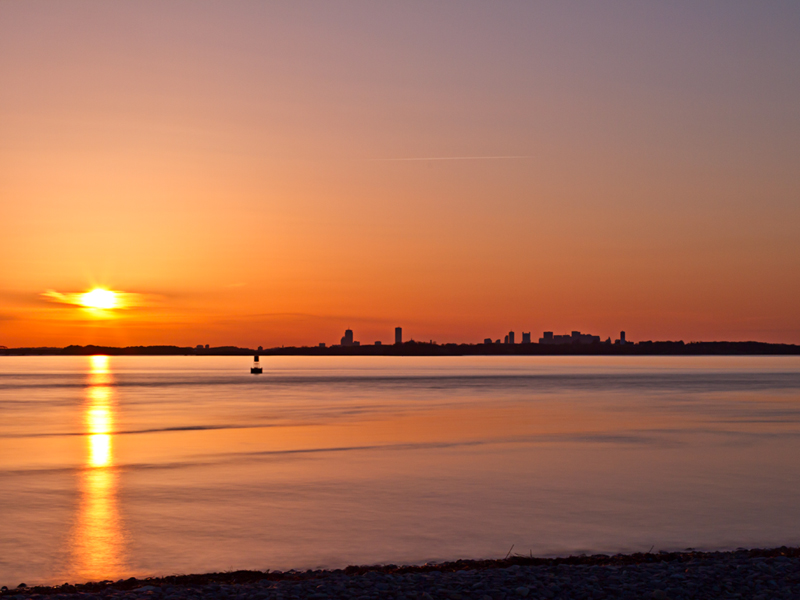I am looking at experimenting with black glass.
Does anyone have experience with ND filters in the 10 stop range?
I am looking for techniques, applications, and perhaps examples.
I am looking at experimenting with black glass.
Does anyone have experience with ND filters in the 10 stop range?
I am looking for techniques, applications, and perhaps examples.
At 10 stops you start to get issues from infrared, so you might consider a hot mirror to reflect the IR. They are more very expensive, but it will save you from increased fringing, flare, and inaccurate color due to infrared. (Normal ND filters only block regular light, not IR, so a 10-stop ND increases the I.R. by one thousand times.)
I've been doing this lately. You can get some very cool images. I stacked a 3-stop ND, a 6-stop ND, and a 2-stop CPL for a total of 11 stops. It turns a 1/60 shot into a 30 second shot. ISO 100, f22, 30 secs

Mark - Flickr
************************
Good input
Any ideas on how much you have to slow the shutter to remove moving people from a scene?
I usually aim for a 30s exposure to blur out pedestrians. Here's an example (apologies, I grabbed these from an old post on CR, and they were saved to my iPhone to post here, not sure what that'll do to them!). This is from my initial testing of the Schneider Optics' (parent company of B+W) 82mm 10-stop ND, which AFAIK is the only one available in that size as a round/threaded filter. These were shot on a 5DII with a TS-E 24mm f/3.5L II. The first is a 1/6 s exposure without the filter, the second is a 30 s exposure with the filter. During the second one, several pedestrians passed through the frame, and some cars as well. You can also see the warmer tone with the filter - could be corrected in post, but for this shot I think the warmer tone is preferable.

I've been playing around with a Hoya HMC ND400 ("Made by Tokina Co.") I got off ebay a while ago.
Focussing on Live-view isn't so hard, tripod is a must obviously, I haven't noticed any colour casting to speak of (I also have a Canon ND8, which makes everything a funky colour).
Here's a shot I took last weekend, about 100km NW of Melbourne. It's the -2/3EV shot of an HDR that I haven't processed yet, just batch-processed in DPP so pretty much the came as a camera JPG.
EFs 15-85 @ 15mm f/5.6, iso100, 10s exposure, ND400 stacked with a Heliopan CPL on top (love that 15-85 vignetting, even better with 2 filters, you can't see it because i've cropped it 3:1). The longer exposure really helped to blur out that damn duck that swam right through my shot (the trail it left behind isn't so bad). I'll re-process later on Landscape style and saturate the colours a bit more when i HDR it...

An awful lot of electrons were terribly inconvenienced in the making of this post.
Gear Photos
The darkest filter I have is a 6-stop. But here are two shots I took with it last year:
Waterfall IMG_0382pp by kayaker72, on Flickr
Falls IMG_2704 by kayaker72, on Flickr
You can see the red hue others mentioned in both shots. This was still after adjust WB in post (DPP at the time). I probably could adjust reds only, but didn't.
Last edited by Kayaker72; 04-22-2012 at 12:35 PM.
OK Great discussion, This is why I keep coming back to TDP.
First Neuroanatomist:
So it looks like a 30 sec exposure was adequate for that shot to remove the objects moving though the scene.
Good info, and you used a 10 step filter.
I assume you checked your exposure, set your focus, then added the filter, then made a 10 stop adjustment to your speed.
I assume you can not focus through a 10stop filter.
Am I close on the technique?
Do you have any comment on a Singh-Ray variable ND (2-8) filter ($340) or the less expensive Genus brand (I believe they have a 1-4 stop and a 2-8 stop)?
Would the variable allow focus through a smaller ND then rotated up and avoid screwing on the ND filter and chance moving the focus ring?
Second Kayaker72:
Can you comment on your technique? Is it similar to how I described above?
What were your settings for each of your shots?
Why do you think you got no motion blurr on the people in the second shot, I assume they moved during the exposure.
Dr Crouble.
I really like your shot? I think it came out fantastic. Is this a panorama or a crop?
Why did you choose f5.6 for such a deep scene?
Thanks for the discussion
FYI
Nice discussion on strobist on this topic
http://strobist.blogspot.com/2010/06...-of-field.html
Spot on about technique. FWIW, I use an iPhone app called Longtime Exposure Calculator to determine exposure adjustment.
A variable ND could be used like that - focus first then darken. I've avoided them for two reasons: not quite dark enough, and more importantly the 'Maltese cross' artifact seen at ~24mm and wider angles (related to the uneven polarization you get with a CPL on an ultrawide lens, since a variable ND is basically stacked polarizers).